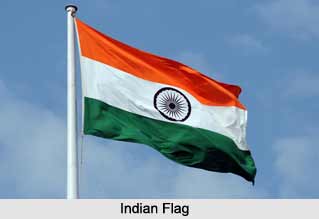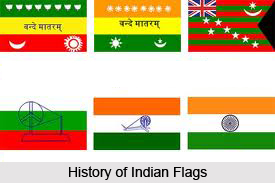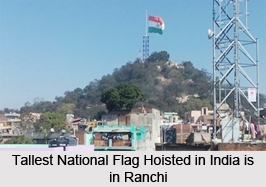 Indian National Flag is of tricolour, consisting of deep saffron (Kesari) at the top, white in the middle and dark green at the bottom in equal proportions. The ratio of the width to the length of the flag is 2:3. In the centre of the white band, there is a wheel in navy blue to indicate the Dharma Chakra, the wheel of law in the Sarnath Lion Capital. The saffron symbolizes courage and sacrifice which is the sacred color of Hinduism. The white stands for peace, purity, unity and truth. The green stands for faith, chivalry and fertility. This centre symbol or the "Chakra" is taken from Ashoka`s Dharma Chakra. Its diameter approximates the width of the white band and it has 24 spokes. Each spoke depicts one hour of the day, portraying the prevalence of righteousness all 24 hours of it.
Indian National Flag is of tricolour, consisting of deep saffron (Kesari) at the top, white in the middle and dark green at the bottom in equal proportions. The ratio of the width to the length of the flag is 2:3. In the centre of the white band, there is a wheel in navy blue to indicate the Dharma Chakra, the wheel of law in the Sarnath Lion Capital. The saffron symbolizes courage and sacrifice which is the sacred color of Hinduism. The white stands for peace, purity, unity and truth. The green stands for faith, chivalry and fertility. This centre symbol or the "Chakra" is taken from Ashoka`s Dharma Chakra. Its diameter approximates the width of the white band and it has 24 spokes. Each spoke depicts one hour of the day, portraying the prevalence of righteousness all 24 hours of it.
Design of Indian National Flag
Indian Flag was designed by Pingali Venkayya. There is a flag code enshrined in the constitution. The official flag specifications require that the flag be made only of "khadi," a special type of hand-spun yarn.
Adoption of Indian National Flag
The National Flag of India was adopted in its present form in the meeting of the Constituent Assembly held on the 22 July 1947. It has served as the national flag of the Dominion of India between the 15th of August 1947 and the 26 January 1950 and that of the Republic of India thereafter.
Code of Indian National Flag
The flag code was changed on 26th January 2002. The Code empowered the citizens of India to fly the Indian flag over their homes, offices and factories on any day. Except some basic rules to follow while flying the flags, all other restrictions have been removed. There are some rules and regulations upon how to fly the flag, based on the 26 January 2002 legislation. These include the following:
Hoisting of Indian National Flag
 1. The National Flag may be hoisted in educational institutions (schools, colleges, sports camps, scout camps, etc.) to inspire respect for the Flag. An oath of allegiance has been included in the flag hoisting in schools.
1. The National Flag may be hoisted in educational institutions (schools, colleges, sports camps, scout camps, etc.) to inspire respect for the Flag. An oath of allegiance has been included in the flag hoisting in schools.
2. A member of public, a private organization or an educational institution may hoist/display the National Flag on all days and occasions, ceremonial or otherwise consistent with the dignity and honour of the National Flag.
3. Section 2 of the new code accepts the right of all private citizens to fly the flag on their premises.
History of Indian Flag
At the beginning of the 20th century, the Indian independence movement seeking freedom from British rule gained momentum. So people felt the need for a national flag which would serve as a powerful symbol of these aspirations. In 1904, Sister Nivedita came up with the first flag of India which was a red square-shaped flag with a yellow inset. It is depicted a "Vajra Chinha" with a white lotus alongside it in the centre.
In another development the first tricolour was unfurled in 1906, during a protest rally against the Partition of Bengal, by Schindra Prasad Bose in Kolkata. This flag came to be known as the Calcutta Flag. On 22nd August 1907, Bhikaiji Cama unfurled another tricolour flag in Stuttgart, Germany. This flag had green at the top, saffron in the centre and red at the bottom. The flag had eight lotuses in a line on the green band representing the eight provinces of British India. The words "Vande Mataram", in the Devanagari script, were inscribed on the central band. On the lowest band, towards the hoist of the flag was a crescent. Later the flag had five red and four green horizontal stripes. On the upper left quadrant was the Union Jack which signified the Dominion status that the movement sought to achieve. A crescent and a star, both in white, are set in top fly. Seven white stars are arranged as in the Saptarishi constellation. In 1916, Pingali Venkayya from Andhra Pradesh tried to devise a common national flag. He with Umar Sobani and SB Bomanji formed the Indian National Flag Mission. They sought Mahatma Gandhi`s approval for the flag. Gandhi suggested the incorporation of the "Charkha" or spinning wheel on the flag, symbolising "the embodiment of India and the redemption of all its ills". Venkayya came up with a flag with the charkha on a red and green background.
Final Adoption of Indian National Flag
The Congress Working Committee appointed a seven member Flag Committee on 2nd April 1931 to find a solution to the designing of the flag. The idea was not favoured by the CWC. Later on a final resolution on the flag was passed when the Congress committee met at Karachi in 1931. The tricolour flag then adopted was designed by Pingali Venkayya. It featured three horizontal strips of saffron, white and green, with a "Charkha" in the centre. The colours were interpreted thus: saffron for courage; white for truth and peace; green for faith and prosperity. The "Charkha" symbolised the economic progression of India and the industriousness of its people.
Constituent Assembly in the First Independent India
The Constituent Assembly was formed to discuss the flag of India in August 1947. They set up an ad hoc committee headed by Dr. Rajendra Prasad and consisting of Maulana Abul Kalam Azad, KM Panikar, Sarojini Naidu, C. Rajagopalachari, KM Munshi and Dr. B.R. Ambedkar as its members. The Flag Committee after three weeks of deliberation on the issue came with the solution that the flag of the Indian National Congress should be adopted as the National Flag of India with suitable modifications, to make it acceptable to all parties and communities. The "Dharma Chakra" which appears on the abacus of Sarnath was adopted in the place of the "Charkha". The flag was unfurled for the first time as that of an independent country on August 15 1947.
Related Articles
Government of India
Indian Flag
Sarnath
Indian National Congress
Sarojini Naidu
Dr. Rajendra Prasad
Dr. B.R. Ambedkar
Mahatma Gandhi
Ranchi
Jharkhand
Delhi
Red Fort
Kolkata
Ashoka




















